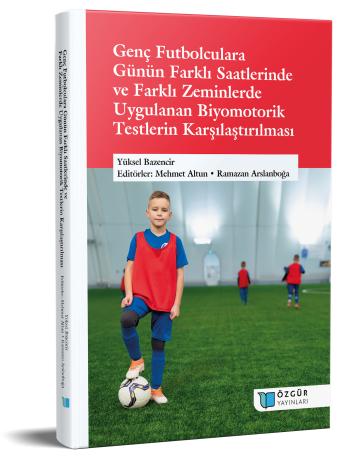
Comparison of Biomotoric Tests Applied to Young Football Players at Different Times and Different Ground
Synopsis
Purpose: The aim of this study was to compare the performance of aerobic capacity and biomotoric properties such as agility, speed, power applied to young footballers at different times and on different grounds. For this purpose, aerobic endurance (20 meter shuttle run), speed (30 meter sprint test), agility (T-Agility Test), flexibility (sit and reach), explosive power (standing long jump) test performances of athletes were compared.
Materials and Methods: Active football players between the ages of 14-16 who were licensed in Giresun Sports Club of Istanbul participated voluntarily. They are licensed footballers for at least 3 years. It was known that the weekly training period of the research club performed 4 units of training for 90 minutes per week. 30 Meters Sprint Test for speed performance, T-Test for agility performance, Standing Long Jump Test for explosive power performance, Sit and Reach test for flexibility and 20 Meter Shuttle Run Test for aerobic capasity value were applied. SPSS 20.0 program was used for the analysis of the obtained data. T test was used to determine whether there is any difference between the groups. Wilcoxon Test was used to determine whether there is a difference between the groups. The level of significance was determined as (p <0.05).
Results: When the statistical analysis of the data obtained as a result of this research is done, the biomotoric tests are compared in terms of soil and time variables; 20m Shuttle Run, Standing Long Jump Test, 30 m Speed Test results between artificial grass floor football field and parquet floor gym, T-test hardwood floor gym and Sit Uzan Test artificial grass floor football field floor variables according to the variable in favor of evening time variable a difference was found (p <0.05). As a result of comparison between groups; No statistically significant difference was found between the 20m Shuttle Test, 30m Speed Test, Standing Long Jump Test, Sit Extension Flexibility Test and T - Agility Test scores applied to the study group according to the artificial turf and parquet floor variables (p> 0.05).
Conclusion: As a result of the analyzes, a significant difference was found between the biomotoric test values of young football players on different grounds and at different times. It is considered that artificial football or parquet hall floors can be used in the test performance measurements of young football players and it may be appropriate to prefer evening time of day (19.00).

